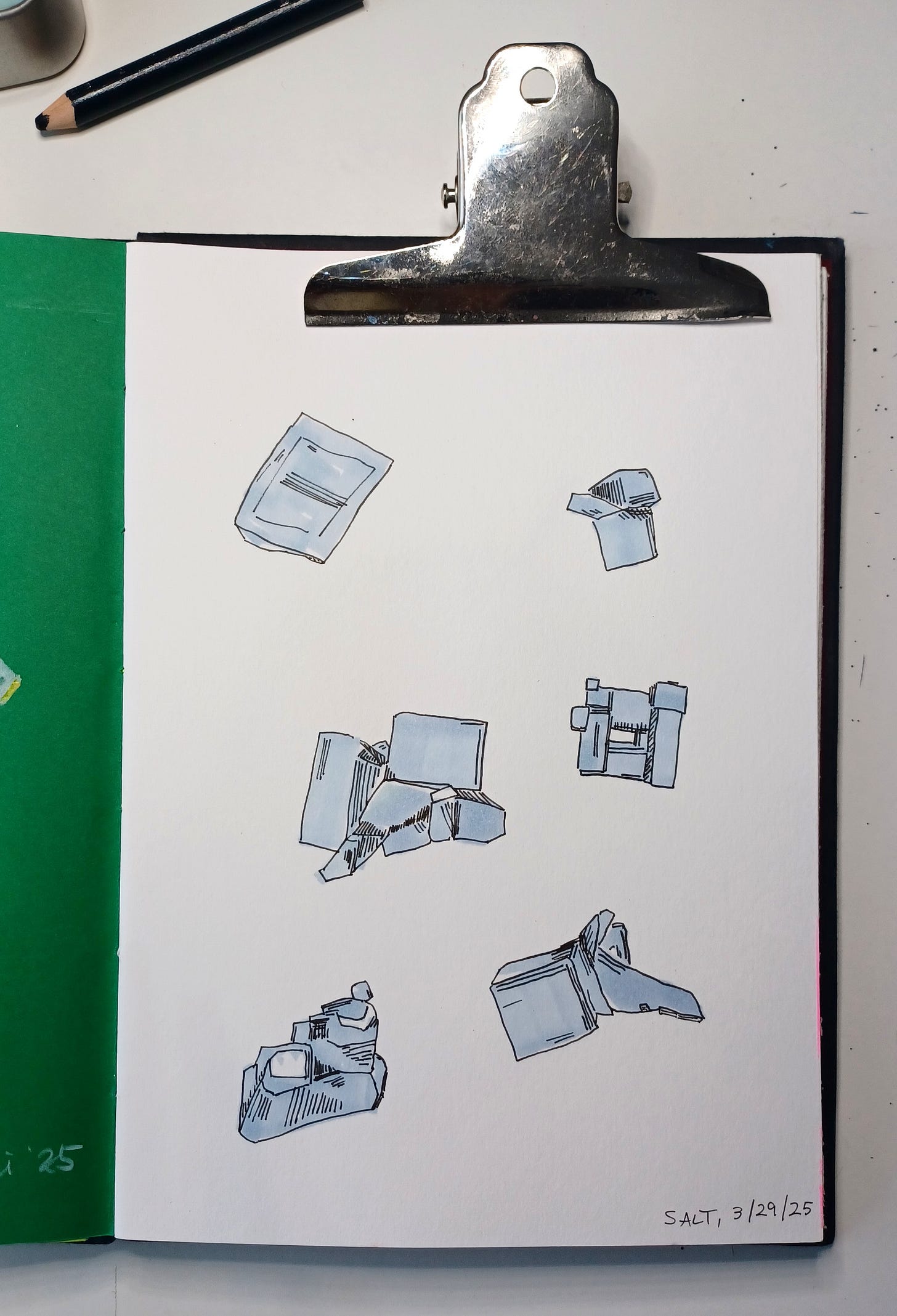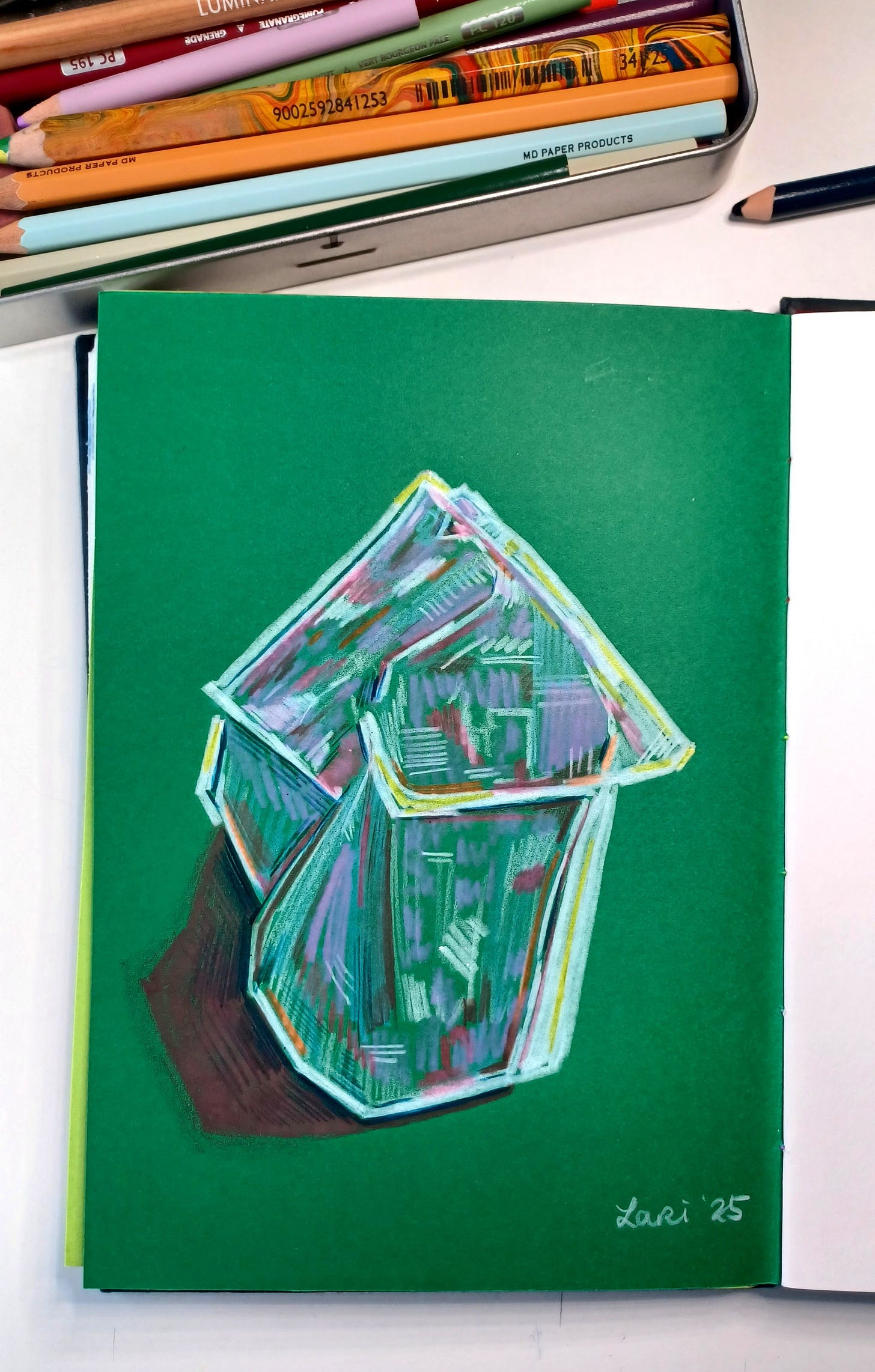I’ve had salt on the mind these days: I’m bringing fleur de sel home to the US as a souvenir; using it for texture in watercolor; incorporating it into my spring cleaning routine… and I’m constantly reminded of its more esoteric uses when I scroll through social media.
I admit to a certain interest in such “alternative” practices as tarot and astrology. Spend any time in that corner of the internet, and you’re gonna see a lot of crystals, candles, runes and sigils, and… salt. It’s frequently used for cleansing and purification, or for protection against evil.
However you may feel about the mystical, it has undoubtedly filtered into wellness circles online, especially since the quarantines of 2020. “WitchTok” has gotten tens of billions of views on TikTok. Online tarot readers, astrologers, and new age energy healer holistic yoga shaman wellness guru lifecoaches are all over social media, ready to cleanse your aura and tell you how to live better and take control over your life.
Why now?
Considering the state of the world we find ourselves in, is it that surprising? These are uncertain, highly charged times. It’s the perfect shitstorm of conditions to flare anxieties around feelings of precarity.
Historically, uncertain times call for coping mechanisms, which can involve the occult, magic, or the supernatural: by demonizing it, or by embracing it. Religion, magic, and witchcraft offer explanations for fortune and misfortune. They can also make people the agent of change, taking power back into one’s own worried hands.
Example 1: The Satanic Panic of the 1980’s happened during a wave of conservatism that followed an economic recession. Pearl-clutching normies created a moral panic out of fear of satanism and sadistic conspiracies.
Example 2: The post-Civil War United States was in upheaval. The human cost of the war that split the country was too much for some to bear. In the hideous aftermath of the war, spiritualists practiced séances to contact the spirits of their lost loved ones. Spiritualism emerged to impart solace to those who needed answers that organized religion couldn’t provide. (For more on this: RENDERED 28: Potatoes)
As New-Age-woo-woo as they may seem to some today, ritual practices that materialize spiritual belief are ancient. Across continents and cultures, one commonality is the importance and ritual use of salt.
Journey back mentally with me to the New Stone Age, the beginning of modern human history. Hunter-gatherers were becoming agriculturists, cultivating the land and domesticating animals. Stonemasonry and metallurgy were new-fangled inventions. Right alongside these early human innovations were the collecting and trading of salt!
The oldest evidence of salt production dates back at least 5000 years, at two sites in Northeastern Romania. Various ancient salt production sites had pottery that once held salt cakes, all of uniform size. Standard-size salt cakes meant it could be more easily inventoried, traded, and sold–hence, it must have been a valuable resource.
For hunter-gatherers, salt wasn’t a necessity: diets rich enough in meat, fish and insects do not physically require supplementary salt. But as hunter-gatherers became agriculturalists, people started eating more grains, so it was more crucial to have access to a salt supply. Domesticated animals needed salt as well–it would stimulate the animal’s appetite, meaning more plentiful, richer milk and cheese. Salt provides nutrients, and it makes food taste better. Salt in food preservation was particularly precious for extending the shelf life of perishable foods.
Besides for food, there are also many practical uses for salt (eg. tanning leather, metallurgy, dyeing fabric), as well as medicinal (eg. for treating toothaches, eliminating stomach worms).
Because salt was so precious in practical uses, it seems logical that folk/spiritual belief might become imbued into it. In the early time of humanity, there was the earth and its burgeoning cosmology. If the sun and stars and natural phenomena should become mythologized, why not the more immediate fundamentals like salt? In various places around the world, there is archaeological evidence to show that salt took on symbolic meaning, and early writings also mention the uses of salt.
Salt was used in ritual offerings dating back to the Western Zhou dynasty of China (1046-771BC).
In ancient Rome, the mola salsa (“salted flour”) was a mixture of salt and ground spelt prepared by the Vestal Virgins, a purifying powder used in ritual offerings to the gods.
Halomancy, or salt divination, was practiced in ancient Greece. Methods could include scattering grains on a surface and reading their shape; reading traces of salt after evaporating salt water in a bowl, like tea leaves; or by throwing salt into a fire and interpreting the spattering of flames.
In ancient Mesopotamia (Iraq today), there is a robust history of salt. It’s referenced in early literature, in proverbs written in Sumerian (c. 3100BCE-2000BCE) and Akkadian (c. 2000BCE-800BCE). Medical prescriptions including salt date back to the Third Dynasty of Ur (c. 2100BCE - 2004BCE). Assyrian King Tiglath-Pileser I (d. 1076BC) left behind writings of his conquests. In one entry, he scattered salt at a city he had vanquished, upon which was built a shrine, thus decreeing that that city should never be rebuilt.
The Maqlû is the best example of salt in magical use in ancient Mesopotamia. The Maqlû (“Burning”) is a series of clay tablets written in cuneiform, dating between 700BC and 600BC). It is an incantation meant to counteract black magic and misfortune.
Prolonged misfortune or suffering meant that one’s personal god was displeased, or had even abandoned the victim. So a ritual was necessary to get back on the personal god’s good side, reconcile with them so they could once again be protected from witchcraft. The salt incantation was one such practice: by offering salted food and adding salt to incense, a victim of godly abandonment and/or witchcraft could hope to both regain the god’s favor and drive away evil witchcraft by performing this magical remedy.
Ritual use of salt does continue today, and not just among New Age neo-Pagan witches. The sumo wrestler throws salt into the ring to purify it. Catholic holy water contains blessed salt. Home cooks might reflexively toss spilled salt over the left shoulder.
Superstition or not, why should one ritual gesture be more venerated than another?
When life feels out of control, there is still power in the individual human gesture. Individual action is within control; in fact, it’s all one can control. Whether it takes the form of ritual, prayer, sigil magic, or simply channeling positive vibes, it is natural to turn to the realm of the spiritual when facing crisis. Considering the intensity of the moment we’re living, I recommend performing whatever gestures bring comfort and a clearer mind.
A note on Hope:
We live in tough times.
Be it financial stress, political outrage, social struggles, the banality of violence, these caustic mental preoccupations feel like an internal pressure cooker. It’s no wonder that people are losing their cool. Doomscrolling, bedrotting, burnout, disconnection, and other such coping techniques serve as temporary panaceas.
I recently had a chitchat with my kindly 93-year-old neighbor. She was gushing about her grandkids (as every proud grandmother does), then she got to talking about the future. Her beaming joy turned to concern. “I tell you, I see what our generation has left for the young, and it worries me. We had so much, and what are we doing with it? Leaving behind problems for our kids, that’s what. It’s not fair to them. I lose sleep at night thinking about it. ” Her indignation read intensely on me.
She seemed to be awaiting a response, and all I could say was “Well, all I can do is have hope. It shows the way forward.” It’s trite, but what more can I say? Words feel futile, but I return to Hope.
Me, I’m trying to find spiritual comfort in the interpersonal, the collective, the ritual, the creative.
My hope is that we find what gives spiritual comfort, and moves us to lean into humanity. Give us some Hope.
Bibliography
Adshead, S.A.M. Salt and Civilization. PALGRAVE, 1992. https://books.google.fr/books?id=B_K-DAAAQBAJ&printsec=frontcover#v=onepage&q&f=false
Dein, Simon. (2016). The Anthropology of Uncertainty: Magic, Witchcraft and Risk and Forensic Implications. Journal of Anthropology Reports. 01. 10.35248/2684-1304.16.1.107. https://www.researchgate.net/publication/334968461_The_Anthropology_of_Uncertainty_Magic_Witchcraft_and_Risk_and_Forensic_Implications
Hoi, Elise. "Salt of the early civilizations: Case studies on China." Penn History Review 18.5 (2011): 9-7. https://core.ac.uk/download/pdf/214162736.pdf
Jones, Claire. “WitchTok: The witchcraft videos with billions of views.” BBC News, 31 Oct 2022. https://www.bbc.com/news/newsbeat-63403467
Macari, Ileana Oana. (2012). Salt in magical procedures. 10.13140/2.1.1903.8727. https://www.researchgate.net/publication/267075765_Salt_in_magical_procedures
Petter, Olivia. “WitchTok: How witchcraft became the latest controversial wellness fad.” The Independent, 27 Jul 2024. https://www.independent.co.uk/life-style/witchcraft-wellness-witchtok-kate-tomas-b2585162.html
Potts, Daniel. “On Salt and Salt Gathering in Ancient Mesopotamia.” Journal of the Economic and Social History of the Orient, vol. 27, no. 3, 1984, pp. 225–71. JSTOR, https://doi.org/10.2307/3631848. Accessed 1 Apr. 2025.
Singer, Barry, and Victor A. Benassi. “Occult Beliefs: Media Distortions, Social Uncertainty, and Deficiencies of Human Reasoning Seem to Be at the Basis of Occult Beliefs.” American Scientist, vol. 69, no. 1, 1981, pp. 49–55. JSTOR, http://www.jstor.org/stable/27850247. Accessed 1 Apr. 2025.
Dominique Sordoillet, Olivier Weller, Nicolas Rouge, Martine Buatier, Jean-Pierre Sizun. “Earliest salt working in the world: From excavation to microscopy at the prehistoric sites of Ţolici and Lunca (Romania).” Journal of Archaeological Science, Volume 89, 2018, Pages 46-55, ISSN 0305-4403. https://doi.org/10.1016/j.jas.2017.11.003. (https://www.sciencedirect.com/science/article/pii/S030544031730167X)
Stackert, Jeffrey. "The Variety of Ritual Applications for Salt and the Maqlû Salt Incantation." Gazing on the Deep: Ancient Near Eastern and Other Studies in Honor of Tzvi Abusch (2010): 235-252. https://www.academia.edu/476182/The_Variety_of_Ritual_Applications_for_Salt_and_the_Maql%C3%BB_Salt_Incantation
“Tablet.” The British Museum. https://www.britishmuseum.org/collection/object/W_K-2950
Tully, Caroline. "Mola Salsa: Sacred Flour from the Hearth of Rome’s Vestal Virgins." (2008). https://www.academia.edu/download/60242099/Mola_Salsa_2008.pdf
Weller, Olivier. “First salt making in Europe: an overview from Neolithic times.” Documenta Praehistorica, 2015, 42, 10.4312/dp.42.12. Hal-03035826f. https://hal.science/hal-03035826v1
Yuhas, Alan. “It’s Time to Revisit the Satanic Panic.” The New York Times, 31 Mar 2021. https://www.nytimes.com/2021/03/31/us/satanic-panic.html







Salt flavors our food with richness. Hope flavors our soul for life.